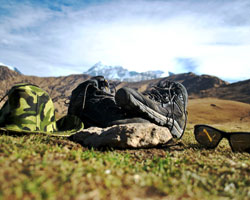Ascending and Descending on Trails
It is critical to understand the concepts of ascending and descending on varied terrain. This lowers the risks of falls, stumbles, strain, and sprains along with conserving energy. The important aspects of ascending and descending techniques are -
- Body Position and Movement
- Pace and Breathing
- Pack weight adjustment
- Gradient adjustment

ASCENDING
1. Body Position and Movement
Stand tall with a straight spine and drop your shoulders. Avoid hinging at the waist. Position your pack in a way that allows for this position. Lean forward and keep your weight on your toes. With each step, extend your legs till they straighten completely. Avoid overextension at the knees and ankles.
2. Pace and Breathing
Maintain a steady pace throughout the day. Find a rhythm between your breathing and your strides. This is more important on long gradual climbs over easy terrain, where it is easy to go faster than your lungs allow. A good rule of thumb is you should be walking at a conversation pace - you should be able to keep talking as you walk.
3. Pack weight adjustment
Loosen your hip and shoulder straps while ascending. If they are too tight, they will constrict your stride and breathing, and cause excessive perspiration. Alternate the weight of the load between your shoulders and hips. This will help minimize muscle tightness and contraction in any single area.
4. Gradient adjustment
- Shorten your stride
- Use zigzag trails or traverse slope sideways
- Use your hands on high step ups
- Use trekking poles
- Take rest steps - with each forward stride, straighten your knees to temporarily shift stress from the muscles to the joints

DESCENDING
1. Body Position and Movement
While descending, there is a natural tendency to lean backward. Avoid this tendency and keep your center of gravity low and over your legs. This will allow you to land on your toes instead of your heels on steeper terrain. Repetitively landing directly on your heels causes high impact forces on your ankles and knees. On shallow terrain, employ the standard heel-to-toe technique. Keep your knees slightly bent on impact to keep the stress on the muscles. Pay attention to foot placement.
2. Pace and Breathing
It is easy to gain more momentum than you can sustain for a long period of time while descending. Be careful about this and maintain a steady pace that helps you avoid slips and reduces the potential for injury. Take short, controlled steps, especially on scree and sand.
3. Pack weight adjustment
While descending, tighten your hip straps to help minimize pack movement, which can hamper your balance. Travel as light as possible. You will feel the pack weight on your back and shoulders more on long descents as compared to uphill sections.
4. Gradient Adjustment
- Shorten your strides and land on your toes
- Use zigzag trails or traverse slope sideways
- Sit down and use your hands for balance on high step downs
- Tighten pack hip belt and shoulder straps

TIPS
- Look forward: Focus your eyes where you want to go, not at your feet. A 45-degree angle or 8-10 feet ahead of your feet is good to start with. This will increase your confidence and improve foot placement, especially on tricky descents.
- Breaks: It is better to walk slowly and take fewer breaks than to walk fast with a lot of breaks. Research suggests that the body and brain go from a stage of activity to a stage of fatigue every 90 minutes. Walk 60-90 minutes, and take a 15-20 minute break.
- Mix it up: Minimize the overuse of muscles in particular areas. Vary your stride, body position, pack adjustment and technique whenever you feel tightness build up in any area.
- Stretching: Keep your muscles supple and avoid injuries by stretching before starting, during breaks and at the end of the day.
- Stay in control and maintain your momentum, especially on scree, sand and other loose terrains.

Ascending and Descending on Snow
While ascending and descending on snow, while you will follow most of the same principles as you do while walking on trails, you will need to make a few adjustments.
1. Body Position and Movement
ASCENDING
Lean forward as you would while climbing a steep trail. Focus sharply on keeping your weight over your toes and your heels raised. This is of more importance while walking on hard snow - you will feel yourself slip immediately if your heels touch the ground.
DESCENDING
While descending, lean slightly backwards and with each step, make a backward kicking motion and strike the ground with your heels first and toes raised.
2. Points of Contact
Using a pair of trekking poles can greatly aid balance while walking on snow. Focus on maintaining three points of contact with the ground at all times - with two poles and two legs. This tripod position is very stable and will prevent most potential falls.
3. Gradient Adjustment
On steep, hard snow trails, it becomes increasingly difficult to walk without traction devices like microspikes or crampons. As the gradient becomes steep and sustained, you can use the zig zag traverse for both the ascent and descent.
- With the inside (upslope) foot, hit the slope with the outer edge of the boot.
- With the outside (downslope) foot, hit the slope with the inner edge of the boot.
- Shorten the pole on your upslope (towards the mountain) side.
- Elongate the pole on your downslope (away from the mountain/towards the valley) side.






